
“Tu ch’entri qua pon mente parte a parte
et dimmi poi se tante meraviglie sien fatte
per inganno o pur per arte”
My visit to Bomarzo was revealing. A deceitful place where everything seems anything else and the Illusion makes you confused and hallucinated. Here I summarize its story and I tried to compare some sculptures to Hypnerotomachia Poliphili‘s illustrations just to have an idea of how this poem influenced the construction of the garden. It’s like fantasy had become stone.
The Garden
Like a romantic and sad story, once upon a time there was a Prince who, after the death of his beloved wife, was so doleful and anguished that decided to built a garden in her remembrance in order to vent his heart.
This prince was the italian nobleman and Duke of Bomarzo Pier Francesco Orsini (1523-1585), called Vicino, and his wife was Giulia Farnese who died in 1560. He called the garden Bosco Sacro or Bosco dei Mostri (Sacred Grove or Monsters’ grove) and the Duke will be concerned in landscaping his garden during all his life .
Like many others Italian Renaissance gardens, Vicino’s park was anything but ornamental, but it has nothing in common with others gardens. It can be considered the anthitesis of the typical Italian garden, such as the nearby Villa Lante in Bagnaia or Villa Farnese in Caprarola, which featured strictly geometrical patterns, vistas, circulation systems and a stringent symbolic logic. The Bomarzo gardens are unique as they do not follow any previously known typology and there will be nothing else like them afterwards.
The Sacred Grove is one of the most astounding creation of the sixteenth century mannerism culture, a precious unicum born to be the only one of his kind in the world, like one of the inscriptions says “sol se stesso e null’altro somiglia”.
The Melancholy Duke
Vicino, eccentric figure of prince -soldier, condottiero and patron of the arts, was very close to Farnese family and friend of the most famous literary men of his time like Bernardo Tasso and Annibal Caro.
The enchenting garden of the Duke is structured in a different levels walk, from the lowest to the highest. Constructed rather with images and ideas, the garden and its statues can be read by the enlightened visitor like a book, providing a philosophical journey through themes such as love, death, memory and truth. Vicino’s garden-book is, however, obscure and ambiguous, and requires a knowledge of poets such as Dante and Petrarch to unravel. It’s possible to see references to chivalric romance poems such as “Amadigi” by Bernardo Tasso and the more famous “Gerusalemme liberata” by his son Torquato as well as “Orlando Furioso” by Ludovico Ariosto and “Orlando Innamorato” by Matteo Maria Boiardo therefore every reading produces a different set of ideas that reflect the complex personality of Vicino himself.
At least some sculpture of the garden have been certainly inspired by Francesco Colonna’s “Hypnerotomachia Poliphili” published in 1499, a long allegory apparently popular with humanists and scholars of the day. It tells of a man, who, in search of his ideal lover, Polia, begins in a trackless and frightening wood, emerges from it parched with thirst, falls asleep, passes through two successive layers or states of dreaming, and awakens in an ideal garden landscape, strewn with odd monuments and the ruins of antique temples, culminating in a blissfull union with Polia.
Some have found alchemical symbols and philosophical connections as walking in the garden from stop to stop, from stage to stage, each element is a component of an immense, neoplatonic poem to Vicino’s lost love. Along with all these possibily interpretations, there’s not a unique and definite explanation so that a sinister appearance, a sense of mystery, and a feeling of terror are constant companions of the visitor to these gardens.
Architects
It’s not really clear the name of the architect who built the garden and there are different theories about the identity of the author: il Vignola, who maybe redesign the Orsini castle; Jacopo del Duca, who eventually would had been inspirated by Villa Palagonia in Sicily; Raffaele di Montelupo sculptor of the huge archangel of Castle Sant’Angelo and Vicino’s friend; Bartolomeo Ammannati to whom are attributed some sculptures in particulary the Tempietto and Pirro Ligorio who is commonly thought to have built Bomarzo garden even though the attribution is not assured (Ligorio designed the Villa d’Este in Tivoli and was later called upon to finish St. Peter’s Cathedral after the death of Michaelangelo).
Actually the park’s project and first constructions was began before Giulia’s death, probably in 1552 as one of the inscriptions says. Maybe the garden was begun by Giulia herself and, after her death, Vicino extended the project in order to include monuments for her remembrance like the Tempietto, designed to be Giulia’s tomb.
What Vicino wanted to say?
Since the rediscovery of the garden, many and different interpretations had been given to explain the meaning of the Sacred Grove. The mystery of the garden has intrigued a lot of art historians like Hans Bredekamp, Maurizio Calvesi, Mario Praz, Bruno Zevi and now there are several theories historians have come up with.
One possibility, suggested by author Christopher McIntosh, is that making this melancholy garden was a form of self-therapy for Orsini to get him out of his depression after the loss of his wife (as we can read in one of the inscription scattered along the park “sol per sfogare il core” that means “just to set the heart free”). McIntosh likens it to a person who is depressed and finds that reading gloomy poetry creates a counter-reaction that cheers him up.
More interesting are the studies of Hans Bredekamp and Maurizio Calvesi (who also studied the Poliphilo and alchemy culture). While Bredekamp tries to focus on each sculpture, inscription or architecture of the park, reading them as an allergoric representation of the known world and others symbols that represent Vicino’s ideas about Life, Death and Afterlife, Calvesi analyzes the garden in relation to poems like “Orlando Innamorato” by Boiardo and “Orlando Furioso” by Ariosto.
Fall and Rebirth
After the Prince’s death, the park was abandoned and lay in overgrown oblivion for centuries until the restoration in 1954 of Giancarlo e Tina Severi Bettini, now buried in the Tempietto. The neglected grove was rediscovered in the 20th century and provided inspiration to a new generation of artists, writers and musicians.
The surrealists Jean Cocteau and Salvador Dalì visited the park. Salvador Dali visited Bomarzo in 1938, shooted a short film there and the park provided inspiration for his 1946 painting “The Temptation of Saint Anthony”. The poet André Pieyre de Mandiargues wrote an essay devoted to Bomarzo. The Dutch magic-surrealist painter Carel Willink used several of the park’s statue groups in his paintings like The Eternal Cry and Balance of Forces. Niki de Saint Phalle was inspired by Bomarzo for her “Tarot Garden” and Tommaso Buzzi was certanly influenced by the Sacred Grove for his villa “La Scarzuola”.
source: beniculturalipatrimoni.it; canino.info; artandarchitecture.org.uk; madamepickwickartblog.com; wikipedia.com
if you want to know more about Bomarzo gardens here’s a interesting study by J.-E. Berger Foundation about Renassaince Gardens in english and french and here a very exhaustive studio by BTA (italian only).

The entrance
At the entry we found two sphinxes and series of heads depicting some of the antique Gods like Saturn, Gianus, Faun, Evandrus and the triple head of Ecatus. The sphinxes introduce you with two riddles. Whoever enters here must prove that he can enter. To gain the right to pass, the riddle of the sphinxes must be solved. Their plinths bear the following inscription:
(this is not where the entrance originally was, it was moved here during the restoration in 1952)


CHI CON CIGLIA INARCATE/ET LABBRA STRETTE/NON VA PER QUESTO LOCO/MANCO AMMIRA/LE FAMOSE DEL MONDO/ MOLI SETTE
(He who does not go there with eyes wide open and lips sealed will not be able to admire the most wonderful marvels)

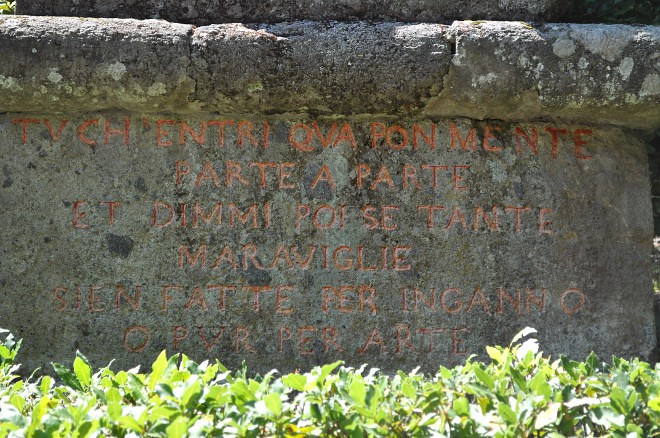
TU CH’ENTRI QUA PON MENTE/PARTE A PARTE/ET DIMMI POI SE TANTE/MERAVIGLIE/SIEN FATTE PER INGANNO O PUR PER ARTE
(Oh ye who enter here and use thy Wit to try to understand what thou shalt see from beginning to end, tell me if so many marvels were created to make the Err or for Art)



Proteus or Glaucus or Mask of Madness
This mask can represent Proteus or Glaucus, the fisherman who became a Marine God after eating a magical herb. A sphere bears the Orsini’s coat of arm and it’s topped by a castle, maybe the Bomarzo’s one.



The Mausoleum
The ruin mausoleum, probably inspired by the Tomba della Sirena of Sovana, is intentionally represented fallen over and half destroyed. It could be referred to the “tempio destructo” a destroyed temple which contained the lovers tombs in the “Poliphilo”.


Hercules slaughters Cacus or The Fighting Colossi
There are two inscription nearby this sculpture and one of them says …TIER GIGANTE….O SCEMPIO…ANGLANTE… It’s easy to recognize the hero of Ariosto’s poem Orlando (Signore d’Anglante), who, during a particularly frenzied stage of his adventures, as he is wandering through a forest, driven mad at the loss of his beloved Angelica to another man, comes across two woodsman, one of whom he slaughters by exactly the method depicted by Vicino’s giants – he catches him by the legs and tears him in two.
The scene could also be referred to the iracund and lustful Giant who slaughters a woman in the Bernardo Tasso’s “Amadigi”.

SE RODI ALTIER GIA FU DEL SUO COLOSSO / PUR DI QUESTO IL MIO BOSCO ANCHO SI GLORIA / E PER PIU NON POTER FO QUANT IO POSSO
(If Rhodes previously took pride from its Collossus so by this one my wood is glorified and further I can do no more than I have done)



the stream in front of Hercules and Cacus

 Pegasus
Pegasus
This mythological figure is very common in renaissance art, but here seems referred to Francesco Colonna’s Poliphilo where Pegasus is illustrated and described as “uno alato caballo che, volando in uno fastigio di monte, una mysteriosa fontana cum il calce faceva surgente”.
 illustration from Hypnerotomachia Poliphili
illustration from Hypnerotomachia Poliphili

 The Turtle
The Turtle
The Turtle and the Fairy upon it stare in the same direction of Pegasus, which is near them. The Fairy could represent the winged Fame.
 illustration from Hypnerotomachia Poliphili (a woman with a turtle an a pair of wing)
illustration from Hypnerotomachia Poliphili (a woman with a turtle an a pair of wing)


 The Whale near the Turtle
The Whale near the Turtle

 The nymphaeum
The nymphaeum
The nymphaeum can be referred to the fount described in the Hypnerotomachia where Polifilo spent a little time with five nymphs, maybe the ones still visible in the niches. In the backround wall we can read part of an inscription:
L’ANTRO, LA FONTE IL LI…….ET…..D’OGNI OSCURO PENSIERO ME GL……


The Three Graces in the Nympheum are mentioned in the Poliphilo too.
illustration from Hypnerotomachia Poliphili

Dolphins fountain
The Fountain in front of the Nympheum probably represent the ship used by Poliphilo and Polia to go to Kithira, island of Love and Venus.

 Jupiter
Jupiter
 Venus
Venus
Poliphilo journey ended in Kithyra, the island of Love, where he found Venus’ Sanctuary and a theatre, just like in Bomarzo’s garden.


The Theatre
On the base of the theatre can be hardly read an inscription saying PER SIMIL VANITA’ MI SON AC…….PARMI CORTO which probably was Per simil vanità mi sono accorto/ che il tempo fugge e il viver parmi corto. Maybe the seven niches today empty were once covered with mirrors, symbols of vanitas.



Near the theatre were found in 1962 two pillars were we can read VICINO ORSINI NEL MDLLII (Vicino Orsini in 1552) and SOL PER SFOGARE IL CORE (just to set the art free) maybe to remember the year were the garden works began and the reason .


The Hanging House
It’s one of the first constructions of the garden, probably wanted by Giulia Farnese in 1555 when Vicino was prisoner. It could represent metaphorically the danger, then avoided, of the family ruin because of Vicino’s captivity.
Near the house there are two inscriptions: CRIST MADRUTIO PRINCIPI TRIDENTINI DICATUM dedicated to Mandruzzo, bishop of Trento since 1539 who probably helped Vicino and set him free; ANIMUS FIT QUIESCENDO PRUDENTIOR ERGO.
The Hanging House could also be identified in the “Torre pericolosa” of Bernardo Tasso’s Amadigi.


 Ceres
Ceres
 Neptune or Pluto
Neptune or Pluto
This big figure is identified as Neptune, God of the seas because of the dolphin in his right hand but seems more realistic the identification with Pluto, God of the underworld, because of the cornucopia and the proximity of the Mouth Hell, Cerberus the Underworld guardian and his wife Proserpina. This part of the garden is inspired by the Gerusalemme Liberata in which we find Pluto who claims his fellow men to fight against christians, the witch Armida here as the sleeping woman, the entry of Hell as the Orc, Cerberus, lions, mermaids, dragons and harpies.


a dolphin near Pluto/Neptune

NOTTE ET GIORNO NOI SIAM QUI VIGILI ET PRONTE/ A GUARDAR D’OGNI INGIURIA QUESTA FONTE


FONTE NON FU TRA…./A GUARDIA SIA DELLE PIU’ STRANE BELVE

The Nymph called the Sleeping Beauty (Ariadne or Armida)
 illustration from Hypnerotomachia Poliphili
illustration from Hypnerotomachia Poliphili


The Dragon
The Dragon is fighting against a dog, a lion and a wolf. In can be a symbol of the Far East that fascinated Vicino but dragons are always been present in christian traditions (ex St. George and the Dragon). The Dragon fighting with lion can represent the struggle between virtue and vice.
 illustration by Lucantonio degli Uberti from a precedent Leonardo drawing of the same subject, in which the Dragon and Lion are labelled with their respective virtues.
illustration by Lucantonio degli Uberti from a precedent Leonardo drawing of the same subject, in which the Dragon and Lion are labelled with their respective virtues.
illustrations from Hynerotomachia Poliphili


The Elephant
Elephants carrying castles were popular symbols in Mediaeval and Renaissance art. They stood for both strength and restraint, and often referred to ancient history, in particular Hannibal’s famous use of Elephants to invade the Italian peninsular. The Bomarzo elephant is a curious instance of this tradition, especially so since it holds a presumably wounded or dead Roman soldier in its trunk, who in turn holds an unidentified object loosely in his right hand.
 illustration from Hypnerotomachia Poliphili
illustration from Hypnerotomachia Poliphili


 The Orc or The Mouth of Hell
The Orc or The Mouth of Hell
The inscription sourrinding the lips of the monster says OGNI PENSIERO VOLA but originally was LASCIATE OGNI PENSIERO VOI CH’ENTRATE (abandon all reason, you who here enter) as we know from a Giovanni Guerra’s drawing dated 1598. The reference to Dante’s inscription above the mouth of hell is clear, although Dante’s damned are told to abandon hope – speranza – rather than reason. Inside Vicino’s hell there is a picnic table, formed by hell’s tongue, and seating space for a small party.

OGNI PENSIERO VOLA (all thought flyes)
 The Cantaro or Big Jar
The Cantaro or Big Jar

The Etruscan Bench
There are a number of shaded and hidden seats in the garden, notably in the Nymphaeum, inviting lovers to linger. This covered bench has a well preserved inscription that dwells on the type of worldly visitor that the garden required, for all its nuanced meanings to unfold:
VOI CHE PEL MONDO GITE ERRANDO / VAGHI DI VEDER MARAVIGLIE ALTE ET / STUPENDE, VENITE QVA, DOVE SON / FACCIE HORRENDE, ELEFANTI, LEONI, / ORSI, ORCHI ET DRAGHI
(You who have travelled the world wishing to see great and stupendous marvels, come here, where there are horrendous faces, elephants, lions, bears, orcs and dragons)


The Hippodrome garden with pinecones and acorns

Echidna and Lions
Many of the features of Vicino’s garden were based, through archaelogical and literary investigation, on ancient Roman models. This was certainly the case with the Hippodrome garden – a large, race-track shaped garden that Vicino based on those common in Roman villas. Those entering the garden, if sufficiently iconographically trained, are warned of a potential threat by the presence of large pinecones and acorns decorating the perimeter. Acorns emblematise the Golden Age, pinecones death, making the Hippodrome a false paradise for unprepared visitors.
Such a threat becomes more pressing in the form of three female figures who roam the Hippodrome; one with bifurcated fish-tails, one with a dragon’s tail, claws and wings, the other surmounting a bench on which only the most foolhardy would sit. These Harpies, according to Darnall and Weil (1984), make another connection with Orlando Furioso, the episode where the King of Ethiopa, Prester John, is rescued from harpies by the hero Astolfo, who drives the harpies into the mouth of hell using magic. Bury (1985) contests the identification of the fish-tailed figure as a Harpy, pointing out, rather sensibly, that she is more likely to be a Mermaid.
Also in the Hippodrome can be found part (the socle) of a copy (according to Darnall and Weil) of the Meta Sudans, an ancient fountain that once stood in Rome between the Colosseum and the Arch of Constantine. The inscripition carried on this base reinforces the idea that the Hippodrome represents a terrestrial paradise.

The Fury
 The Rotonda (Meta Sudans ?)
The Rotonda (Meta Sudans ?)
It’s a circle fountain placed at the end of the staircase leading to the Tempietto. On his base the insctription says:
CEDAN ET MENPHI E OGNI ALTRA MARAVIGLIA/CH HEBBE GIA L MONDO IN PREGIO AL SACRO BOSCHO/CHE SOL SE STESSO E NULL ALTRO SOMIGLIA
(Memphis and every other marvel that the world has held in praise yield to the Sacro Bosco that resembles itself and nothing else)

 The Cerberes
The Cerberes


The Tempietto
The philosophical journey through the sacred grove ends at a strangely constructed temple. This was the last costruction of the garden and was built by Vicino as the culmination of his memorials to Giulia, and as a symbol of her constancy.
We know this latter detail from a book published in 1556, Le Imagine del tempio della signaro Giovanna Aragona, by Giuseppe Betussi, in which Giulia Farnese Orsini is referred to as amongst the most virtuous ladies of Italy, on account of her constancy, having remained faithful to Vicino during the long periods when he was absent at war.
The ceiling is decorated with lilies, symbol of Farnese family and roses, symbol of Orsini family. Drawings by Giovanni Guerra show that the temple, now quite bare, was once adorned with a number of symbols including the zodiacal signs, crucifixion and resurrection scenes, and a sun that looked out from the east overlooking the Sacro Bosco. Solar light symbolises the revelation at the end of the philosophical journey through Vicino’s Sacro Bosco, the visitor emerging out of the wood, with its fantastical and cautionary bestiary, to the idea of divine love, emanating from the purity of Giulia, and embodied in the architecture of the Tempietto.
This temple could also represent the place where Polia met Poliphilo.
 illustration from Hypnerotomachia Poliphili
illustration from Hypnerotomachia Poliphili



Giancarlo and Tina Bettini restored the garden in 1952 and now are buried in the Tempietto

Little Bear
Two little bears holding the Orsini coat of arm are setted at the end of the Hippodrome garden. They represent Vicino himself via a pun as in italian “orsino” means little bear.
 Orsini Castle from the garden
Orsini Castle from the garden
Poliphilo sleeping in the wood







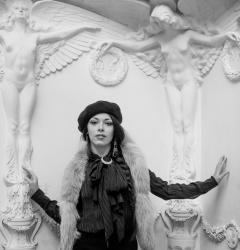


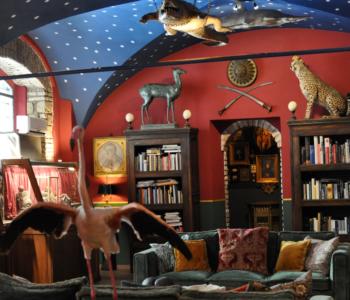
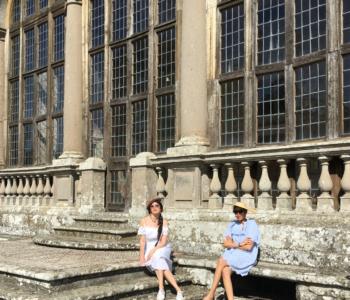
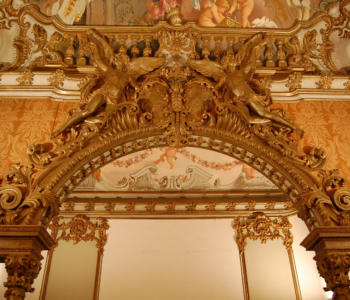
Trackbacks per le News